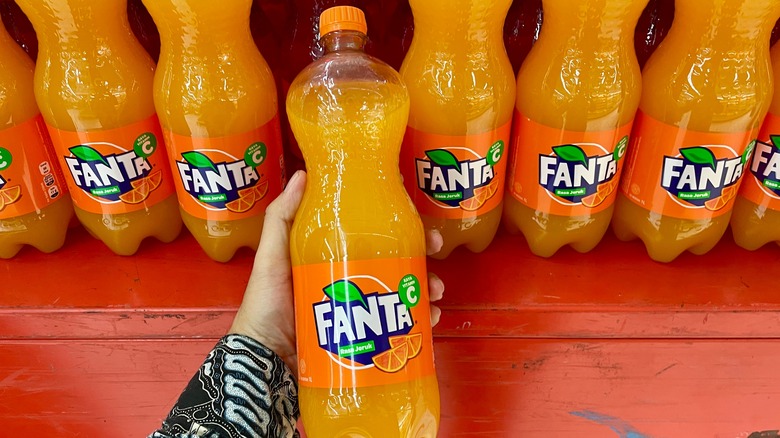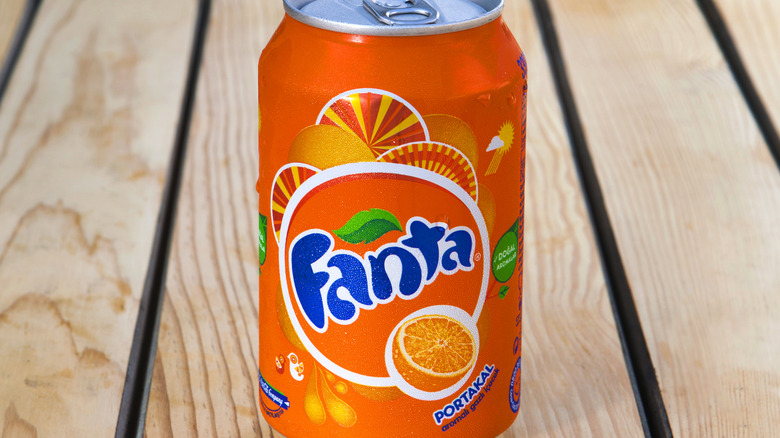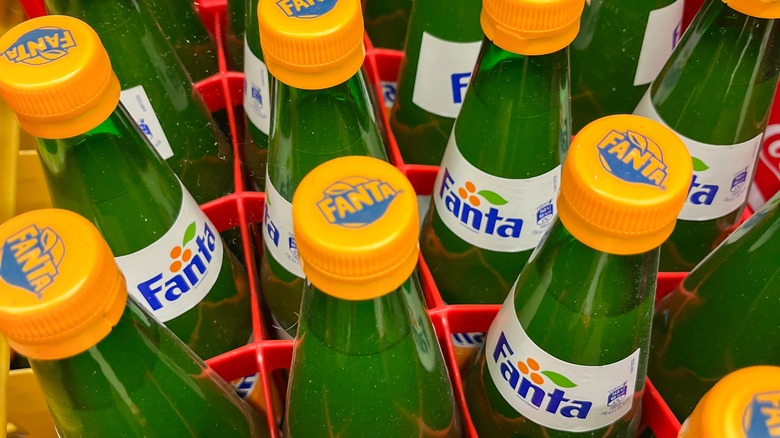Fanta Soda Was Originally Created For Nazis
When you think of Fanta soda, what comes to mind? Guessing it's a candy-colored swirl of ladies dancing on the beach and imploring, "Wanna Fanta?" Coca-Cola's beloved line of fruit-flavored sodas has a decidedly Latin spin to its marketing, so it's easy to assume the drink was invented in South America. However, Fanta is a soda born deep inside Nazi Germany at the height of World War II — the result of a concerted effort by Coke's German division to keep the lights on during wartime by any production methods necessary.
Coca-Cola's extensive family of sodas, waters, teas and more can be found in over 200 countries today. The company continues to innovate with exciting new flavors like Coca-Cola Spiced and limited offerings like Coca-Cola Starlight. But back in the 1930s, Coke was just beginning to expand its footprint internationally, and hadn't strayed from its core beverage. Despite the double whammy of the Great Depression and global war impacting other markets, the Coke business in Nazi Germany thrived — that is, until various trade embargoes following America's entrance into WWII made importing its proprietary syrup flavor impossible. Undaunted, Coke's then-head of German operations instructed his team to invent a new soda using their existing resources. The result was Fanta.
Fanta was invented out of Nazi food scraps
In 1906, Coca-Cola opened bottling facilities in its first three non-US markets, Cuba, Panama, and Canada. European facilities followed in France in 1919, with Germany's first Coca-Cola bottling plant opening in 1929 in Essen. The German business got off to a shaky start, until the enterprising Max Keith took over operations in the thirties. A company man through and through, Keith strove to rebrand Coke from an all-American drink to the choice for Nazi Germany, including sponsorship of the 1936 Summer Olympics held in Berlin. Keith's strategy paid off with stronger German Coke sales, but he couldn't stave off the full trade embargo with the US post-Pearl Harbor.
Max Keith was determined to keep the soda flowing in Germany for Coke. As the formula for Coca-Cola is top-secret, Keith collaborated with German chemists to attempt to create a caffeinated flavor as close to the real thing as possible. With access to ingredient resources throttled, this crew got very creative. They used food scraps from local produce vendors, including apple fibers left over from cider production, and whey. You know, like "curds and whey" — the stuff usually cast aside after making cheese.
The resulting drink certainly wasn't Coca-Cola, but it was marketable. In a country starved for luxuries, Keith asked his staff to envision their fantasies when trying to christen the new soda. Sales rep Joe Knipp suggested they simply call it Fanta, and the name stuck.
Fanta was a big seller in Nazi Germany
Fanta was one of the few German soda options still in production during wartime. Original batches of Fanta contained saccharin, given the prevalent sugar rationing in the country. As the soda grew in popularity — not only as a drink, but as a cooking sweetener for equally industrious home chefs — Germany allowed the makers of Fanta access to beet sugar. Fanta sales climbed gradually, enabling Coca-Cola to stay afloat as a German entity until Allied liberation in 1945.
Although Max Keith worked closely with the Nazis in creating and marketing Fanta, there is no evidence that Keith was a Nazi himself. His loyalty was to Coca-Cola, keeping German operations running despite not being able to communicate with his American colleagues. While Fanta's original production stopped with WWII's conclusion, Coke was impressed enough that they reformulated and relaunched the brand as Fanta Orange in Italy in 1955.
Coke consistently rolls out new Coca-Cola Creations these days, such as K-Wave Zero Sugar, meant to appeal to a global audience. It's mind-blowing to consider that Coke's corporate spirit of unity and diversification started with one German Coke exec's willingness to play nice with Nazi Germany by inventing Fanta. (We'll take a citrusy modern Fanta over the original apple-cheese leavings flavor any day.)


